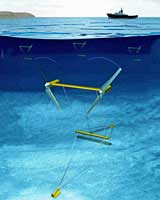A prototype of what is likely to be the first turbine for tapping the tidal energy of New Zealand waters is sailing around Scottish seas bolted to a ship.
Christchurch company Neptune Power wants to begin installing an experimental turbine in Cook Strait next summer, based on the design being tested off Scotland.
Neptune received resource consent from the Greater Wellington Regional Council this month for a trial that can last up to 10 years.
Neptune director Chris Bathurst said the company was awaiting the results of the shipboard testing before buying a turbine from the unnamed manufacturer.
So far it has been established that the turbine rotates as intended and now performance and reliability testing is under way.
"Because they wanted to measure how much power it develops at exact speeds, they've bolted it to the front of this vessel, which is much easier than measuring where you've got variable tidal flows," Bathurst said.
The turbine Neptune intends installing at a cost of $10 million 4.5km off Wellington's Island Bay will have a maximum generation capacity of 1MW - enough for about 500 homes.
That is a fraction of the 12GW of power - 1.5 times New Zealand's present generation capacity - Bathurst calculates could be extracted from Cook Strait at a cost of billions.
Bathurst, a mechanical engineer with a background in the aluminium smelting industry, is not daunted by that sum. He says he is well versed in capital raising, having been involved from the beginning in a successful US$1.3 billion smelter project in Mozambique.
"I'm quite sure we could bring in overseas money for this because people will see it as a way of attracting carbon credits."
But he wants New Zealand investors to have priority, and would like up to a third of the venture's value to be available to the public.
"We've turned various offers of investment down because first we wanted to get resource consent and know that the technology is going to work. Then we would go after the money, and we're at that stage now."
It is intended that the turbines will be made in New Zealand. The 14m-diameter machines are made of carbon fibre so yacht builders are potential manufacturing partners.
The turbine's carbon fibre construction should give it three times the generation capacity per tonne of a conventional wind turbine, Bathurst said.
"It's very light. That means when we get into mass production it will be correspondingly cheaper as well. Manufacturing costs generally are in line with the mass of the materials used."
Bathurst can see New Zealand becoming an exporter of marine energy expertise in the same way that it is a world leader in geothermal power generation.
The turbine itself might be light but it will be held in place by a concrete tank weighted with 700 tonnes of a material that is yet to be finalised.
The trial turbine will be anchored with a heavier weight than is likely to be needed for the production turbines because it is not known what forces they will have to withstand.
"After we've had it down for a period and analysed the forces, we'll be able to be more accurate about the weight needed."
The turbine will be placed in waters known as the "Karori rip", an area where the tidal current changes orientation from east-west to north-south where Wellington juts into Cook Strait.
"That speeds up the current at that point - a bit like a bend in a river," Bathurst said.
Power from the trial turbine is expected to be brought ashore at Vector's Island Bay substation..

